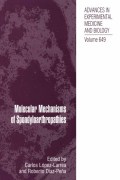
Molecular Mechanisms of Spondyloarthropathies aims to synthesize this growingknowledge and present all the current studies concerning the basic research of SpA. Over the last decade, enormous progress has been made in the understanding of the molecular and cellular processes that lead to disease pathology. Recognition of the pathways involved in the pathogenic mechanisms of disease andthe potential to target specific immune effector functions have opened the door to a wide range of innovative treatment opportunities for the SpA. Thus, webelieve that the understanding of the specific molecular mechanisms involved would help to design highly specific drugs in the future. The contributors areamong the best in their field and reflect the state of the art of research and current opinion of rheumatologists and immunologists. INDICE: From the contents 1. Clinical Assessment in the Spondyloarthropathies.- 2. Imaging in Spondyloarthritis.- 3. Spondyloarthritis, Diffuse Idiopathic Skeletal Hyperostosis (DISH) and Chondrocalcinosis.- 4. The Enthesis Organ Concept and its Relevance to the Spondyloarthropathies.- 5. Synovial and Mucosal Imunopathology in Spondyloarthritis.- 6. Bone Loss in the Spondyloarthropathies: Role of Osteoclast, Rankl, Rank and Opg in the Spondyloarthropathies.- 7. RankL/Rank as Key Factors for Osteoclast Development and Bone Loss in Arthropathies.- 8. Bone Formation Versus Bone Resorption in Ankylosing Spondylitis.-9. Biomarkers in Spondyloarthropathies.- 10. Therapy of Spondyloarthritides.-11. Genomewide Screens in Ankylosing Spondylitis.- 12. Subtypes of HLA-B27: History and Implications in the Pa thogenesis of Ankylosing Spondylitis.- 13. Implications of Structural and Thermodynamic Studies of Hla-B27 Subtypes Exhibiting Differential Association with Ankylosing Spondylitis.
- ISBN: 978-1-4419-0297-9
- Editorial: Springer
- Encuadernacion: Cartoné
- Páginas: 340
- Fecha Publicación: 01/06/2009
- Nº Volúmenes: 1
- Idioma: Inglés
